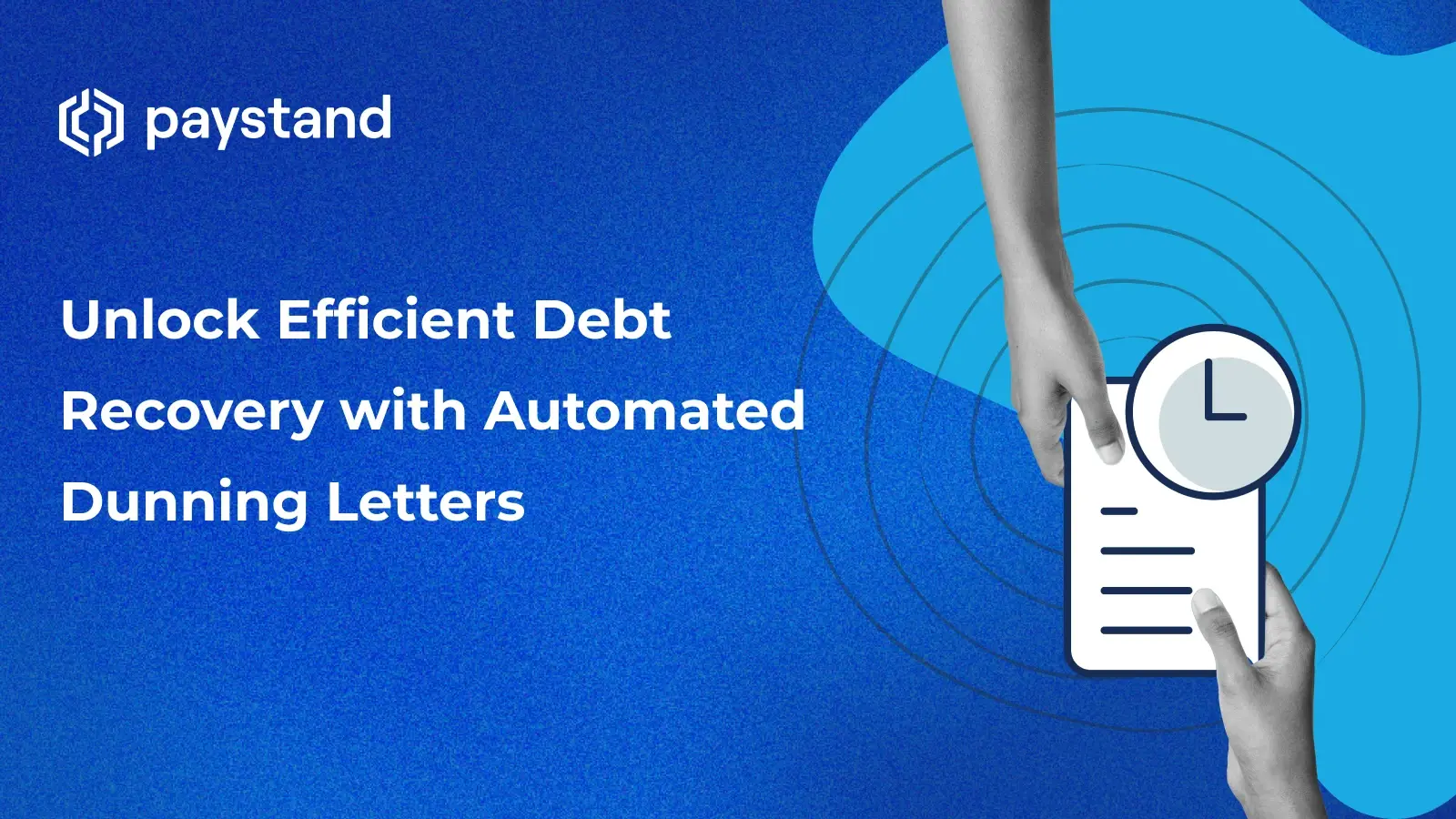Unlock Efficient Debt Recovery with Automated Dunning Letters

Table of Contents
- What are delinquent accounts?
- What is a dunning letter?
- How to automate a dunning letter?
- The traditional dunning process vs. automated dunning
- Empower your debt recovery with Paystand
Key Takeaways
- Traditional dunning letters help businesses remind customers of unpaid invoices, but manual processes can be inefficient and impact cash flow.
- AR automation enhances dunning by automating reminders, offering multi-channel communication, and integrating payment options to improve collections.
- Automated dunning letters include smart payment reminders, personalized messaging, and seamless payment options to increase response rates.
- AR automation provides real-time tracking, AI-driven insights, and automated escalations to optimize collections and reduce Days Sales Outstanding (DSO).
- Paystand’s blockchain-powered AR automation streamlines debt recovery with intelligent workflows, frictionless payments, and enhanced receivables management.
Dunning letters, or dunning emails, have been a structured way for businesses to remind customers about unpaid invoices, reduce late payments, and maintain a positive relationship with customers. However, collections teams sometimes face accounts receivable challenges getting invoices paid, directly impacting their Days Sales Outstanding (DSO).
In today's dynamic business landscape, relying solely on traditional dunning letters may not yield optimal results. With evolving technology and consumer preferences, AR automation software can transform the dunning process by automating reminders, providing multi-channel communication, and integrating payment options to improve cash flow. Let's explore these modern solutions further.
What Are Delinquent Accounts?
Before we explain the AR automation-enhanced dunning process, we must understand delinquent accounts.
A delinquent account is a customer who has not paid within the 30-day payment window. Typically, collections teams categorize delinquent accounts as 30, 60, 90, and 120 days late. The main reasons behind late payments often include cash flow problems, increased costs, damaged relationships, and legal problems.
Once you’ve identified your customers' delinquency, automated accounts receivable management can categorize accounts, trigger personalized reminders, and offer flexible payment solutions without manual intervention.
What is a Dunning Letter?
Dunning letters or emails are essential for streamlining debt collection and contacting customers about unpaid bills. They are designed to remind customers of their unpaid invoices and encourage them to pay promptly. However, manual dunning letters can be time-consuming and inefficient.
With AR automation software, businesses can send automated reminders and follow-ups tailored to customer payment behaviors. By integrating real-time tracking and insights, companies gain visibility into which customers respond best to different follow-ups.
How to Automate a Dunning Letter?
If you’re still writing dunning emails manually, these key components ensure their effectiveness:
- Automated Identification: Use automated templates to dynamically populate customer names, outstanding balances, and invoices, eliminating manual errors.
- Smart Payment Reminders: Instead of static letters, send customizable dunning strategies based on customer history.
- Multi-Channel Communication: Deliver reminders through email, SMS, or even chatbot notifications to increase response rates.
- Seamless Payment Options: Embed a billing payment portal or ‘Pay Now’ links to simplify transactions.
- Real-Time Customer Support: Provide contact information with live chat or automated response options for customer inquiries.
By minimizing manual errors and enhancing compliance, AR automation helps businesses maintain consistency and efficiency.
The Traditional Dunning Process vs. Automated Dunning
| Aspect | Traditional Dunning | AR Automation-Enhanced Dunning |
|---|---|---|
| Follow-ups | Manually tracked and sent | Automated reminders & follow-ups |
| Communication | Email or mail | Multi-channel: SMS, chatbots, emails |
| Personalization | Generic letters | Tailored messages based on payment behavior |
| Payment Process | Manual bank transfers | Integrated payment portals for one-click transactions |
| Tracking | No real-time insights | Real-time tracking & insights for AR teams |
| Compliance | Risk of errors in reminders | Minimized manual errors & enhanced compliance |
Automating dunning eliminates inefficiencies, reduces late payments, and improves cash flow stability.
Optimizing Dunning Letter Performance with AR Automation
To optimize the dunning process, AR automation provides:
- A/B testing for dunning strategies: Experiment with different messaging and reminder sequences to find the most effective approach.
- Customer segmentation: Automatically group customers based on payment history, enabling targeted strategies.
- AI-driven insights: Use real-time analytics to adjust messaging and payment incentives dynamically.
- Automated escalations: Gradually increase urgency through a structured, rule-based escalation process rather than manual intervention.
By implementing these automation strategies, businesses can significantly improve their accounts receivable management and accelerate cash flow.
Empower Your Debt Recovery with Paystand
Effective communication is crucial for streamlining debt collection. By leveraging AR automation software, businesses can replace outdated dunning letters with intelligent, automated workflows that increase payment success rates.
Paystand, a leading provider of blockchain payments and AR automation solutions, transforms the dunning process with automated reminders, integrated payment portals, and real-time tracking. Say goodbye to manual collections and hello to frictionless, efficient receivables management.
Rethink your financial processes today. Download our free ebook, "The Guide to Best AR Automation 2025", and discover how automation can revolutionize your accounts receivable strategy.





